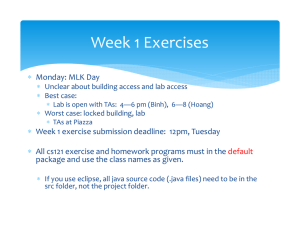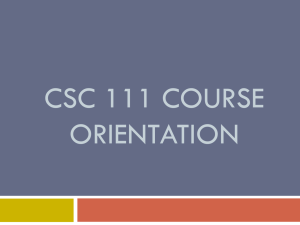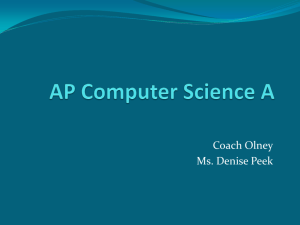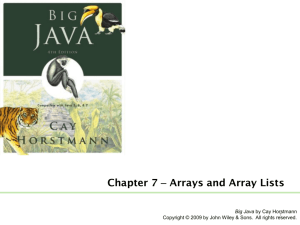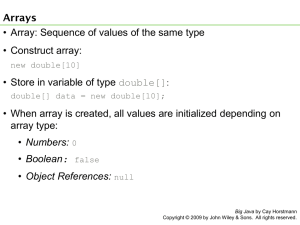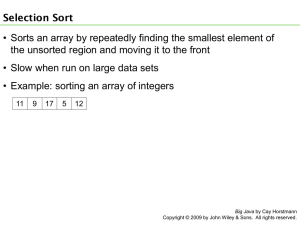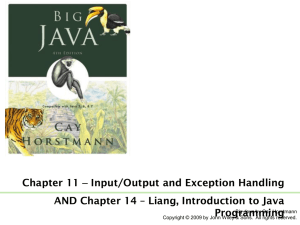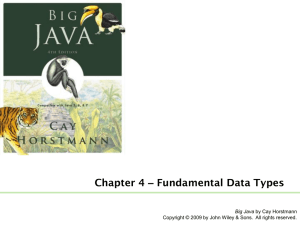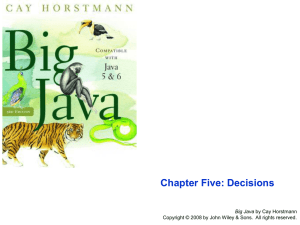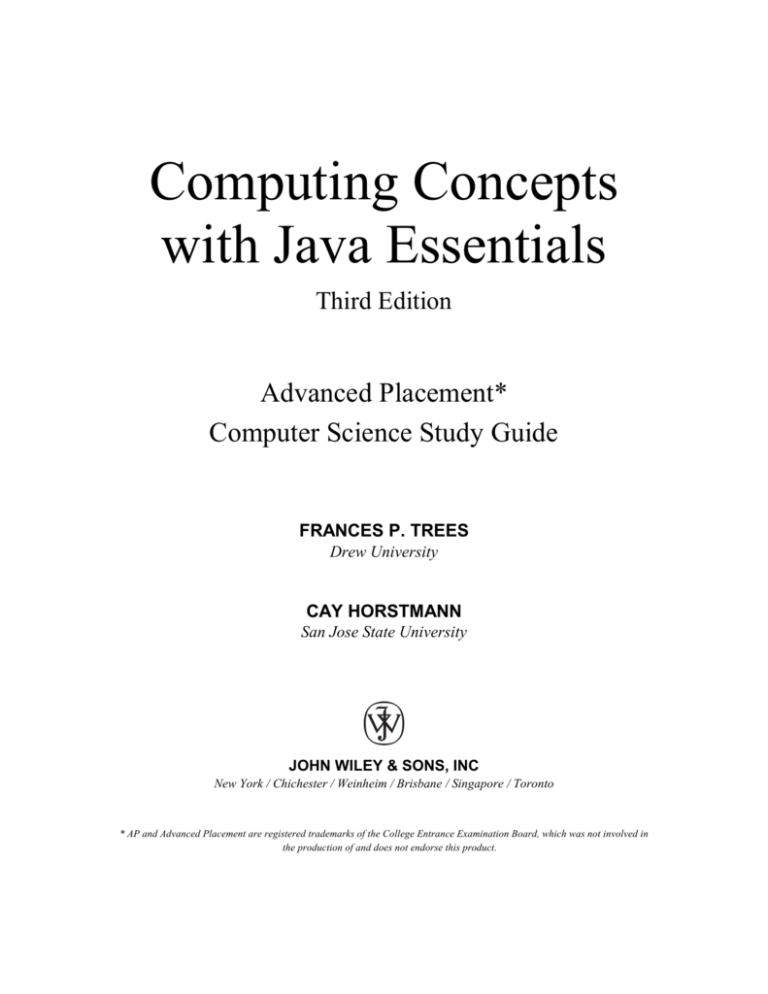
Computing Concepts
with Java Essentials
Third Edition
Advanced Placement*
Computer Science Study Guide
FRANCES P. TREES
Drew University
CAY HORSTMANN
San Jose State University
JOHN WILEY & SONS, INC
New York / Chichester / Weinheim / Brisbane / Singapore / Toronto
* AP and Advanced Placement are registered trademarks of the College Entrance Examination Board, which was not involved in
the production of and does not endorse this product.
ACQUISITIONS EDITOR
MARKETING MANAGER
PROJECT MANAGER
EDITORIAL ASSISTANT
COVER DESIGN
Paul Crockett
Katherine Hepburn
Cindy Johnson
Simon Durkin
Susan Cyr / Harry Nolan
This book was set in Times New Roman and printed and bound by J&M Reproductions. The
cover was printed by J&M Reproductions.
This book is printed on acid-free paper.
The paper in this book was manufactured by a mill whose forest management programs include
sustained-yield harvesting of its timberlands. Sustained-yield harvesting principles ensure that
the numbers of trees cut each year does not exceed the amount of new growth.
* AP and Advanced Placement are registered trademarks of the College Entrance Examination
Board, which was not involved in the production of and does not endorse this product.
Copyright 2004 John Wiley & Sons, Inc. All rights reserved.
No part of this publication may be reproduced, stored in a retrieval system or transmitted in any
form or by any means, electronic, mechanical, photocopying, recording, scanning or otherwise,
except as permitted under Sections 107 or 108 of the 1976 United States Copyright Act, without
either the prior written permission of the Publisher, or authorization through payment of the
appropriate per-copy fee to the Copyright Clearance Center, 222 Rosewood Drive, Danvers, MA
01923, (978) 750-8400, fax (978) 750-4470. Requests to the Publisher for permission should be
addressed to the Permissions Department, John Wiley & Sons, Inc., 111 River Street, Hoboken,
NJ 07030, (201) 748-6011, fax (201) 748-6008, E-Mail: PERMREQ@WILEY.COM. To order
books or for customer service, please call 1–800–CALL–WILEY (225–5945)
ISBN 0-471-44939-3
Printed in the United States of America
10 9 8 7 6 5 4 3 2 1
ii
PREFACE
This Study Guide is designed to assist high school students preparing for the AP Computer
Science Examination. It is organized and designed to accompany Computing Concepts with Java
Essentials, 3rd. ed., and Big Java, both by Cay Horstmann and published by John Wiley & Sons,
Inc.
To the Student
Advanced Placement Computer Science is a college level course. As a student in an AP course,
you are expected to understand college level material and to read college level textbooks.
Because these texts may be used in multiple college courses, they contain material that is not
tested on the AP Computer Science (CS) Examinations. This guide identifies and stresses the
content that is tested on the AP CS Exams. This does not imply that you should skip the
additional material in the text. Your teacher may include the additional material in your course
and hold you responsible for that material. Some of the material that is not tested on the exam is
extremely useful and may be included in your course. By following this guide, you will be able
to focus on the topics included in the AP CS 2003-2004 Topic Outline and the elements of the
AP Java subset that will be tested on the exam. Because the guide is designed for students taking
either the A or the AB Computer Science exam, topics covered on the AB Exam are marked “AB
only.” If you are participating in an AP CS A course, this should not discourage you from
reading these sections; it merely indicates that those topics will be tested on the AB exam and not
the A Exam.
Features of the Study Guide
This guide is organized to help students recognize and master those topics that will be tested on
both the A and AB examinations. Where applicable, each chapter includes:
Topic Summary
This section parallels the material in the textbook, adding additional examples and explanation of
topics presented in the text. Students will find special emphasis here on topics that are likely to
be tested.
Expanded Coverage of Topics not Found in the Text
Any topics in the AP CS Topic Outline or the AP Java subsets that are not covered in the text are
presented in this section. In addition, Appendix A includes two additional textbook chapters that
expand the coverage of data structures and algorithms needed for the AP exam.
iii
Topics That are Useful but not Tested
This section alerts students to sections of the textbook that present useful features of the Java
language. Although these sections are not required for the AP exam, they address features of
Java programs that students are likely to encounter, or that they will need to progress in their
programming ability.
Things to Remember When Taking the Exam
Each chapter restates important concepts and provides specific suggestions for avoiding common
errors.
Key Words
Vocabulary used in the chapter is listed alphabetically here for student review and reference.
Each key word is accompanied by the page number(s) where it is defined and/or discussed in the
text.
Connecting the Detailed Topic Outline with the Text
This listing links the topics presented in the guide to the pages in the text where the same topics
are covered.
Practice Questions (Multiple Choice and Free Response)
A large number of practice questions, modeled after those on the AP exam, are included in each
chapter. The questions use the multiple-choice and free-response formats that students will
encounter on the exam. Answers to the practice questions are provided in Appendix D.
AB Examination Topics
Any sections (and practice questions) that cover topics that will not be tested on the Computer
Science A exam are clearly marked “AB only.” Students who are preparing for the AB exam
should be sure to complete these sections.
Web Resources
The AP Computer Science Topic Outline and Quick Reference Guides that students may use
during the AP exam are available from the College Board’s Web site at
http://www.collegeboard.com/ap/students/compsci/. The Quick Reference Guides list the classes,
interfaces, and methods contained in the Java subset covered by the AP exam. The AP Computer
Science Topic Outline and the AP testable Java subsets may be revised from time to time, so you
are encouraged to check for the most current version of these documents in the AP Computer
Science Course Description on the College Board site.
Web sites associated with this guide and with Computing Concepts with Java Essentials, 3rd.
ed., and Big Java are another important resource for users of this guide. Cay Horstmann’s site,
http://www.horstmann.com, contains an expansion of Chapter 19, Help with Common
Compilers, that provides installation tips and getting started instructions for the most commonly
used Java compilers and environments. You will also find source code for programs in the text(s)
and Appendix A, solutions to selected exercises in the text(s), frequently asked questions, a
programming style guide, and more.
iv
Many of these same items are also available from the Wiley Web site
http://www.wiley.com/college/horstmann, plus instructor resources not available to students.
at
Acknowledgments
It has been a sincere pleasure working with Cay Horstmann, master computer scientist and
teacher, in the creation of this guide. I will always value this experience.
Many thanks to Paul Crockett for providing the opportunity for me to be involved in this project
and to Cindy Johnson and her staff at Publishing Services for their hard work, support, and
patience throughout. I am extremely grateful to Joe Kmoch, Washington High School, whose
review offered many valuable comments and suggestions. I also am grateful to Judy Hromcik,
Arlington High School, and David Levine, St. Bonaventure University, for their suggestions and
encouragement.
My energy and enthusiasm for AP Computer Science is constantly renewed by the many AP CS
teachers that I work with at AP CS workshops and, of course, by my AP CS students, some of
whom are now AP CS teachers!
Finally, thanks to Eli for his patience, encouragement and support.
This work is dedicated to my mother.
F.T.
v
vi
CONTENTS IN BRIEF
1. Introduction
1
2. Hardware and Software (1)*
9
3. Introduction to Objects and Classes (2)
4. Fundamental Data Types (3)
5. Decisions (5)
6. Iteration (6)
35
55
73
7. Designing Classes (7)
93
8. Testing and Debugging (8)
113
9. Interfaces and Polymorphism (9)
10. Inheritance (11)
121
137
11. Array Lists and Arrays (13)
12. Exception Handling (14)
13. System Design (16)
14. Recursion (17)
17
163
195
207
221
15. Introduction to Sorting and Searching (18)
16. Introduction to Data Structures (AB) (19)
235
263
17. Advanced Data Structures (AB) (20, A-20, and A-20A)
18. Information about the Case Study
19. Help with Common Compilers
303
355
359
A. Advanced Data Structures and Algorithms (Expanded Coverage)
B. Exercise Solutions
*
368
437
Parenthesis indicates the corresponding chapter in Computing Concepts with Java Essentials, 3rd ed., and Big Java.
vii
CONTENTS
1.
2.
viii
Introduction 1
1.1 What is Advanced Placement? 1
1.1.1 Computer Science as an AP
Subject
1.2 Who Takes AP Courses? 2
1.2.1 Who Takes AP CS?
1.3 What is the Difference between AP
Computer Science A and AB? 3
1.3.1 AP CS Course Organization
1.4 Which Elements of Computer Science
Are on the AP Exam? 4
1.4.1 Format of the AP CS Exam
1.5 Strategies for Taking the AP CS
Exam 4
1.5.1 Strategies for Part 1
1.5.2 Strategies for Part 2
1.5.3 Materials
1.5.4 Last Minute Reminders
1.6 How are the Exams Graded? 6
1.6.1 Special Recognition for Doing
Well
1.7 How Should this Guide be Used to
Prepare for the AP CS Exam? 7
1.8 Where Can I Get More Information? 7
1.8.1 Where Can I Get the Text
Ancillaries?
1.9 Are There Other Suggestions for
Success in AP CS? 8
Hardware and Software 9
2.1 Hardware Components 9
2.1.1 The Anatomy of a Computer
2.2 System Software 10
2.3 Types of Systems 10
2.4 A Simple Program 10
2.4.1 Escape Sequences
2.4.2 Java Comments
2.5 Errors 11
3.
Introduction to Objects and Classes 17
3.1 Using and Constructing Objects 17
3.2 Object Variables 18
3.2.1 Importing Classes
3.3 Defining a Class 20
3.4 Testing a Class 21
3.5 Instance Fields 21
3.6 Constructors 22
3.7 Designing the Public Interface of a
Class 22
3.7.1 Overloading
3.8 Commenting the Public Interface 23
3.9 Specifying the Implementation of a
Class 23
3.10 Variable Types 25
3.11 Explicit and Implicit Method
Parameters 26
4.
Fundamental Data Types 35
4.1 Number Types 35
4.2 Assignment 36
4.3 Constants 37
4.4 Arithmetic and Mathematical
Functions 38
4.4.1 Calling Static Methods
4.4.2 Type Conversion
4.5 Strings 42
4.6 Comparing Primitive Types and
Objects 44
5.
Decisions 55
5.1 The if Statement 55
5.2 Comparing Values 56
5.2.1 The null Reference
5.2.2 Dangling else
5.3 Using Boolean Expressions 61
5.3.1 Short Circuit Evaluation
5.3.2 Using Boolean Variables
6.
7.
Iteration 73
6.1 while Loops 73
6.2 for Loops 74
6.3 Nested Loops 76
6.4 Off-by-1 Errors 77
6.5 Random Numbers and Simulations 78
6.6 Loop Invariants (AB only) 79
Designing Classes 93
7.1 Choosing Classes 93
7.2 Cohesion and Coupling 94
7.3 Accessor and Mutator Methods 95
7.4 Parameter Passing 95
7.5 Side Effects 98
7.6 Preconditions and Postconditions 98
7.6.1 Class Invariants (AB)
7.7 Static Methods 100
7.8 Static Fields 100
7.9 Scope 101
7.9.1 Scope of Local Variables
7.9.2 Scope of Class Members
7.10 Initializing Variables 101
7.11 Packages 102
8.
Testing and Debugging 113
8.1 Unit Tests 113
8.2 Test Case Evaluation 114
8.3 Program Traces and Assertions 114
8.4 The Debugger 115
9.
Interfaces and Polymorphism 121
9.1 Developing Reusable Solutions 121
9.2 Converting Between Types 127
9.2.1 Constants in Interfaces
9.3 Polymorphism 128
10. Inheritance 137
10.1 Introduction to Inheritance 137
10.2 Inheritance Hierarchies 141
10.3 Inheriting Instance Fields and
Methods 143
10.4 Subclass Construction 143
10.5 Converting from Subclasses to
Superclasses 144
10.6 Abstract Classes 147
10.7 Access Control 148
10.8 Object: The Cosmic Superclass 148
10.8.1 Overriding the toString
Method
10.8.2 Overriding the equals
Method
11. Array Lists and Arrays 163
11.1 Array Lists 163
11.1.1 A Word about Efficiency
11.1.2 Wrapper Classes
11.2 Arrays 169
11.2.1 One-Dimensional Arrays
11.2.2 Another Word about
Efficiency
11.2.3 Two-Dimensional Arrays (AB)
12. Exception Handling 195
12.1 Introduction to Exceptions 195
12.2 Understanding Unchecked
Exceptions 196
12.3 Throwing Exceptions (AB only) 199
13. System Design 207
13.1 Designing Software Systems 207
13.2 The Software Life Cycle 208
13.3 Discovering Classes 208
13.4 Relationships between Classes 208
13.5 Responsibilities of a Class 209
14. Recursion 221
14.1 Thinking Recursively 221
14.2 Permutations 223
14.3 Tracing Through Recursive
Methods 225
14.4 Recursive Helper Methods and Mutual
Recursion 226
14.5 A Word About Efficiency 226
15. Introduction to Sorting and Searching 235
15.1 Selection Sort 235
15.1.1 Analyzing the Performance of
the Selection Sort Algorithm
15.2 Insertion Sort 238
15.2.1 Analyzing the Performance of
the Insertion Sort Algorithm
ix
15.3 Merge Sort 241
15.3.1 Analyzing the Performance of
the Merge Sort Algorithm
15.4 Quicksort (AB only) 243
15.4.1 Analyzing the Performance of
the Quicksort Algorithm
15.5 Comparing O(n 2) and O(n log(n)) (AB
only) 245
15.6 Sequential Search 246
15.6.1 Analyzing the Performance of
the Sequential Search
Algorithm (AB only)
15.7 Binary Search 247
15.7.1 Analyzing the Performance of
the Binary Search Algorithm
15.8 Comparing O(n) and O(log(n)) (AB
only) 248
16. Introduction to Data Structures (AB) 263
16.1 Using Linked Lists 263
16.2 Implementing Linked Lists 268
16.2.1 Doubly Linked Lists
16.2.2 Circularly Linked Lists
16.2.3 Header and Trailer Nodes
16.3 Abstract and Concrete Data Types280
16.4 Stacks 281
16.5 Queues 284
17. Advanced Data Structures (AB) 303
17.1 Sets 303
17.2 Maps 304
17.3 Hash Tables 306
17.3.1 Using HashSet
17.3.2 Implementing HashSet
17.3.3 Using HashMap
17.3.4 Implementing HashMap
17.4 Computing Hash Codes 314
17.5 Binary Search Trees 314
17.5.1 Binary Tree Traversals
17.5.2 Searching a Binary Search
Tree
17.5.3 Removing a Node from a
Binary Search Tree
17.6 Using Tree Sets and Tree Maps 322
17.7 Priority Queues 330
17.8 Heaps 333
17.8.1 Implementing a Heap
17.8.2 The Heapsort Algorithm
17.9 Choosing a Container 335
x
18. Information about the Case Study 355
18.1 What Is a Case Study? 355
18.2 Why Are Case Studies Included in AP
CS? 356
18.3 How Do I Use the Case Study During
the School Year? 356
18.4 How Do I Prepare for the Case Study
Questions on the AP Exam? 356
18.5 Where Do I Get the Case Study? 357
19. Help with Common Compilers 359
19.1 Java 2 Platform 359
19.2 Command Line Programming 360
19.3 Common Integrated Development
Environments 361
19.3.1 BlueJ
19.3.2 Eclipse
19.3.3 JCreator
19.3.4 JJ
19.3.5 Metrowerks CodeWarrior
19.3.6 NetBeans
Appendices
A. Advanced Data Structures and
Algorithms (Expanded Coverage) 368
B. Exercise Solutions 437


